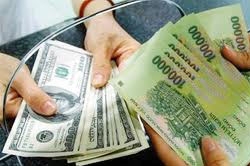All calm on the forex front
 |
| illustration photo |
Though the rate was relatively stable in the past three months, industry experts warn the 2010’s scenario might return unless relevant agencies came up with appropriate measures to lock down the forex market.
A government report in late June 2011 showed that the dong lending slid 0.43 per cent in total amount as of June 20, 2011 against the previous month and only hiked 2.76 per cent compared to late 2010. Meanwhile, dollar lending rose 2.43 per cent against the previous month and surged 23.5 per cent against late 2010.
“In 2010, the [dong-dollar exchange] rate was fairly stable in the first seven months. Then the forex market incurred a growing tension in the second half of the year until early 2011,” said a Vietinbank branch director Pham Xuan Hoe.
Accordingly, total committed foreign direct investment in the first half of 2011 was just half of that during the same period in 2010 and the economy now faces a growing trade deficit and lower remittance inflows.
Besides, businesses rushing into taking dollar loans are also susceptible to risks. To avoid high dong lending rates of over 20 per cent, many local firms resort to taking dollar loans then convert them to dong.
Central Institute for Economic Management deputy head Dr. Vo Tri Thanh assumed the current exchange rate stability would be unsustainable as the exchange rate faced great pressures amid spiraling trade deficit and inflation. To keep the rate stable in the long run, raising local people and businesses’ confidence in the dong currency was essential, according to Thanh.
Vietnam Small and Medium Size Enterprises Association chairman Dr. Cao Sy Kiem said the dong-dollar exchange rate would incur growing tension late in the year due to seasonal features and the rate’s volatility would depend chiefly on the way central bank handled fiscal and monetary policies and the outcomes of inflation busting Regulation 11/NQ-CP enforcement.
Scores of financial and banking experts assumed to have a stable exchange rate in the long term the State Bank must have huge dollar volumes to control the market when necessary. The State Bank reportedly bought $3 billion in dollar reserves so far this year.
Deposited dollar amounts saw a 3.6 per cent decline as of June 20, 2011 against late May. The situation, however, is expected to change following central bank’s Circular 13/2011/TT-NHNN which regulates that from July 1, 2011 state-owned corporations, groups and their member units holding over 50 per cent of state ownership capital are obliged to sell dollars to credit organisations. If the circular is properly handled, it will help ease the dollar tension by the year end, paving the way for a stable dong-dollar exchange rate in the long term.
What the stars mean:
★ Poor ★ ★ Promising ★★★ Good ★★★★ Very good ★★★★★ Exceptional
 Tag:
Tag:
Related Contents
Latest News
More News
- Long-term capital seen as key hurdle to green growth (December 16, 2025 | 08:00)
- Gold prices swing amid tax debate and import uncertainty (December 15, 2025 | 18:04)
- Agribank frames bank credit as catalyst for green growth (December 15, 2025 | 17:59)
- Vietnam’s green transition demands collective financial action (December 15, 2025 | 12:00)
- VIR workshop highlights capital and policy for sustainable development (December 15, 2025 | 11:00)
- Promoting digital assets initiative in Vietnam (December 13, 2025 | 09:30)
- Experts flag gaps as national financial strategy under review (December 12, 2025 | 15:13)
- Global gold exchange models offer roadmap for Vietnamese market (December 12, 2025 | 11:58)
- Five million household businesses to adopt self-declared tax system (December 11, 2025 | 18:13)
- Vietnam establishes management board for crypto asset trading market (December 11, 2025 | 18:11)
























 Mobile Version
Mobile Version